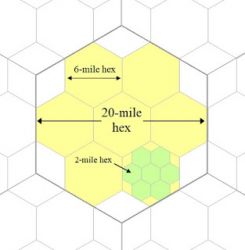Hex Group
Hex groups are used in mapmaking to provide cohesion to the random distribution of infrastructure. The game world is mapped in 20-mile hexes, this being the best size for estimating travel times for player characters and determining the movement of goods and services. As a means of expanding details of the game world, these hexes are progressively subdivided into smaller and smaller hexes, reaching all the way down to the combat hex, which is 5 ft. across.
Scale
20-mile hexes are subdivided into nine hexes that are 6.67 miles across, called "six-mile hexes" as a simplified misnomer. Two of these nine hexes are shared with adjacent 20-mile hexes, as shown in the sketch provided. Six-mile hex maps are used for local regions and to calculate general productivity and wealth. A Hex Group describes the infrastructure distribution inside the 20-mile hex, among the six-mile hexes, as determined by the method described below. Each individual hex is defined by its Hex Type, from 1 to 8, by how much infrastructure exists inside that one six-mile hex.
Six-mile hex maps are subdivided into nine hexes that are 2.22 miles across, called "two-mile hexes." These are used for closely mapping areas where the party has settled, where great detail is needed for clarification. The "Hex Type" defines how many of these two-mile hexes are domesticated rather than wild.
Distributing Groups
This describes the means by which the infrastructure of the 20-mile hex is distributed among the seven prime, or whole six-mile hexes forming the hex group. Infrastructure numbers range from zero (no habitation or infrastructure at all) into the thousands — though for distributing groups, an infrastructure of 448 or more means the hex group is fully civilised.
A hex group with zero infrastructure has seven type-8 hexes; "type-8" being the least civilised type. Every six-mile hex in this group is wild, without any human structures or facilities. If adjacent to human culture, a hex like this would be considered "hinterland" — visited regularly by hunters and gatherers, but with nothing more developed than an animal-made trail.
1 point of infrastructure would mean the hex group has six type-8 hexes and one type-7 hex. This type-seven hex, 6.67 miles across, has one two-mile hex within it that's civilised. The remainder of the 2 mile hexes, and most of the six-mile hex, is counted as hinterland. A single point of infrastructure is very little. It's understood, then, that the "hex type" is determined by how many two-mile hexes within that six-mile hex are civilised. None equals a type-8 hex; one equals a type-7; two equals a type-6 and so on, until if every two-mile hex is civilized, the six-mile hex is a type-1. Conversely, if there are no wild hexes, that's a type-1; and for each wild hex that's added, the hex becomes type-2 (one wild hex), type-3 (two wild), type-4 (three wild) and so on. While this counting systems seems confusing at first, it quickly becomes second-nature.
